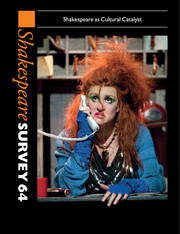Book contents
- Frontmatter
- CONTENTS
- ILLUSTRATIONS
- The Commercial Bard: Business Models for the Twenty-First Century
- International Innovation? Shakespeare as Intercultural Catalyst
- Brand Shakespeare?
- Global Shakespeare 2.0 and the Task of the Performance Archive
- An International Database of Shakespeare on Film, Television and Radio
- ‘Sounds and Sweet Airs’: Music in Shakespearian Performance History
- Using Shakespeare with Memes, Remixes and Fanfic
- ‘Pretty Much how the Internet Works’; or, Aiding and Abetting the Deprofessionalization of Shakespeare Studies
- Catalysing What? Historical Remediation, the Musical, and What of Love's Labour's Lasts
- Kabuki Twelfth Night and Kyogen Richard III: Shakespeare as a Cultural Catalyst
- The Sonnets as an Open-Source Initiative
- ‘A Stage of the Mind’: Hamlet on Post-War British Radio
- Post-Textual Shakespeare
- I am What I am Not: Identifying with the Other in Othello
- Desdemona's Book, Lost and Found
- Non-Catalyst and Marginal Shakespeares in the Nineteenth-Century Revival of Catalan-Speaking Cultures
- Shakespeare, Mácha and Czech Romantic Historicism
- An Irish Catalysis: W. B. Yeats and the Uses of Shakespeare
- François-Victor Hugo and the Limits of Cultural Catalysis
- ‘You Taught me Language’: Shakespeare in India
- There is Some Soul of Good: An Action-Centred Approach to Teaching Shakespeare in Schools
- The Royal Shakespeare Company as ‘Cultural Chemist’
- Shakespeare at the White Greyhound
- Dark Matter: Shakespeare’s Foul Dens and Forests
- What We Hear; What we see: Theatre for a New Audience's 2009 Hamlet
- Narrative of Negativity: Whig Historiography and the Spectre of King James in Measure for Measure
- Québécois Shakespeare goes Global: Robert Lepage's Coriolan
- Endless Mornings on Endless Faces: Shakespeare and Philip Larkin
- Shakespeare Performances in England 2010
- Professional Shakespeare Productions in the British Isles, January–December 2009
- The Year’s Contribution to Shakespeare Studies
- INDEX
- References
Brand Shakespeare?
Published online by Cambridge University Press: 28 November 2011
- Frontmatter
- CONTENTS
- ILLUSTRATIONS
- The Commercial Bard: Business Models for the Twenty-First Century
- International Innovation? Shakespeare as Intercultural Catalyst
- Brand Shakespeare?
- Global Shakespeare 2.0 and the Task of the Performance Archive
- An International Database of Shakespeare on Film, Television and Radio
- ‘Sounds and Sweet Airs’: Music in Shakespearian Performance History
- Using Shakespeare with Memes, Remixes and Fanfic
- ‘Pretty Much how the Internet Works’; or, Aiding and Abetting the Deprofessionalization of Shakespeare Studies
- Catalysing What? Historical Remediation, the Musical, and What of Love's Labour's Lasts
- Kabuki Twelfth Night and Kyogen Richard III: Shakespeare as a Cultural Catalyst
- The Sonnets as an Open-Source Initiative
- ‘A Stage of the Mind’: Hamlet on Post-War British Radio
- Post-Textual Shakespeare
- I am What I am Not: Identifying with the Other in Othello
- Desdemona's Book, Lost and Found
- Non-Catalyst and Marginal Shakespeares in the Nineteenth-Century Revival of Catalan-Speaking Cultures
- Shakespeare, Mácha and Czech Romantic Historicism
- An Irish Catalysis: W. B. Yeats and the Uses of Shakespeare
- François-Victor Hugo and the Limits of Cultural Catalysis
- ‘You Taught me Language’: Shakespeare in India
- There is Some Soul of Good: An Action-Centred Approach to Teaching Shakespeare in Schools
- The Royal Shakespeare Company as ‘Cultural Chemist’
- Shakespeare at the White Greyhound
- Dark Matter: Shakespeare’s Foul Dens and Forests
- What We Hear; What we see: Theatre for a New Audience's 2009 Hamlet
- Narrative of Negativity: Whig Historiography and the Spectre of King James in Measure for Measure
- Québécois Shakespeare goes Global: Robert Lepage's Coriolan
- Endless Mornings on Endless Faces: Shakespeare and Philip Larkin
- Shakespeare Performances in England 2010
- Professional Shakespeare Productions in the British Isles, January–December 2009
- The Year’s Contribution to Shakespeare Studies
- INDEX
- References
Summary
Not a brand…
In recent years, the notion of ‘the Shakespeare brand’ has provided scholars with a ready metaphor to describe Shakespeare's remarkable cultural and commercial purchase in the twenty-first century. Doug Lanier has titled Shakespeare ‘the Coca-Cola of canonical culture’, and critics have explored the deployment of ‘the Shakespeare brand’ from the production of eighteenth-century editions to the marketing of twentieth-century screen adaptations of his plays. Most recently, ‘Deploying the Shakespeare Brand’ was the topic of a lively seminar at the International Shakespeare Conference in Stratford-upon-Avon in 2010, that explored the commercial presence of ‘Shakespeare’ in, among other things, cartoons, crafts and film.
In many ways, ‘brand’ is a helpful term with which to understand Shakespeare's cultural purchase. With it, scholars can acknowledge that ‘Shakespeare’ has a symbolic function in the world quite separate from (if partly rooted in) the facts of his existence and the content of his plays. The range of associations ‘Shakespeare’ bears – from excellence to Englishness – can be deployed in new, profitable, ways. That his image graces ‘bank cards, £20 notes (from 1970–93), beer, crockery, fishing tackle, book publishing, cigars, pubs, and breath mints’ is a familiar trope of reception studies. As critics have observed, too, ‘Shakespeare’, like any successful brand name, is attached to a seemingly endless series of new products, from stage and film adaptations to souvenir money-boxes, medallions and tea-towels, and even the dizzying realms of ironic, academic kitsch – ‘the Shakespeare beanie baby, the Shakespeare bobble-head, the Shakespeare action figure, or the Shakespeare celebriduck (a rubber bath duck adorned with the face of Shakespeare)’. ‘Brand’ provides space for scholars to consider the meanings and values that Shakespeare brings to, and accrues in, these new settings. ‘The Shakespeare brand’ extends the opportunity, too, for scholars to reflect on Shakespeare's unusual leverage – for good or ill – in academic publishing, employment and student recruitment.
- Type
- Chapter
- Information
- Shakespeare Survey , pp. 25 - 37Publisher: Cambridge University PressPrint publication year: 2011
References
- 1
- Cited by



